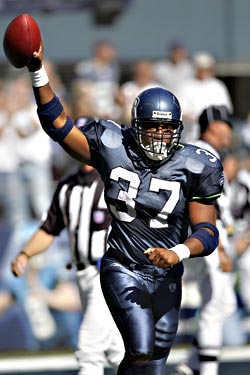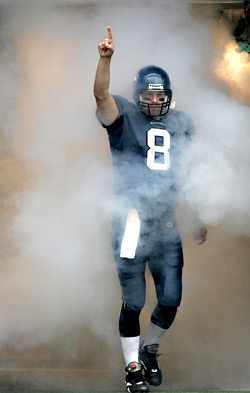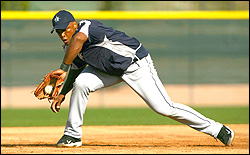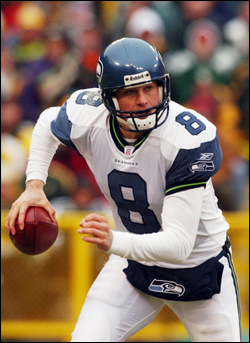THE TERM DEADLINE endeared itself in the penal colony where, if a guy wearing a striped suit strayed beyond an agreed-upon boundary, another fellow, in a watchtower, got to pick up a rifle and shoot the offender dead. With modern baseball, a few deadline details have changed. Now, if a general manager strays beyond 12 a.m. Aug. 1 without trading for a guy in a striped suit (or some other uniform), the offended fans get to make the G.M. wish he were dead.
Such is the plight of poor Seattle Mariners GM Pat Gillick as I file this report on Tuesday, July 29 (deadlines being what they are). With the rest of the Mariners Nation, I’m monitoring the wires and squawk-jock stations, awaiting word of a trade that will allow the M’s to win the remainder of their games and maybe even make it all the way to the American League Championship Series again. (And no, obviously, the trade late Tuesday of Tacoma Rainiers outfielder Kenny Kelly for .207-batting New York Mets shortstop Rey Sanchez doesn’t fit the bill.)
I can’t help myself. Watching the train wreckI mean trade deadlineapproach has become more compelling than many of the games. Yapping about possible, improbable, and impossible trades now lasts longer most summers than the presence in front of your house of that summer-fun RV your neighbor’s in-laws drove out from Bemidji.
The latest “maybe” trade, Flaky Freddy Garcia for gimpy Cardinals outfielder J.D. Drew, may have blown up in the third inning Sunday, July 27, when Garcia helped a 2-0 M’s lead become a 5-2 deficit: not exactly what the St. Louis scout who was present was hoping to observe.
BUT THAT’S THE M’S lately. Merely complacent for much of June and July, they greeted post-All-Star-break games with a shrugging lethargy to belie the notion that a pennant race is upon them. Playing a not-very-winsome brand of win-some, lose-some baseball, they somehow hold a division lead against an Oakland team with eight starters who each hit .255. No wonder local fans dream of upgrade scenarios: Freddy, say, for a third baseman who hits 62 home runs a year and makes three errors. Even if it were possible, what would you do with the ballclub’s real problem, Jeff Cirillo? What GM ever could accept a Cirillo trade, knowing that the M’s $6.45 million man only hits during months with “R” in them? On the other hand, things do eventually go away, small things such as baseballs left by Freddy on the outside corner of the plate, large things such as the federal budget surplus and . . .
Vin Baker! If the Sonics could chump the Celtics with the Baker deal, then most anything is possible, maybe even a way to move Cirillo. It would require creativity well beyond what Gillick and his predecessors have shown. (Recall the breathtaking deadline debacle of 1997, when the teamtalk about train wreckssent Jose Cruz Jr., Jason Varitek, and Derek Lowe to Toronto and Boston for Mike Timlin, Paul Spoljaric, and Heathcliff Slocumb.) It also requires an utter absence of sentimentality, meaning all but Ichiro and a few others should be expendable. Gillick indicated as much as the deadline approached. But Mariner management is oriented toward the future, sometimes at the expense of the present. The great minds know that Garcia, Mike Cameron, and others will become even pricier commodities after this season; they’re also obviously aware that a wealth of pitching (though a paucity of helpful position players) waits down on the farm.
As far as trade strategy goes, a certain literary sensibility also has hypnotized big-league baseball, heretofore a not exactly bookish bunch. This would remain the case had it not been for the arrival of Moneyball, Michael Lewis’ anecdotal story about how the Oakland A’s (and suddenly some other clubs) triumph by using eight guys named Joe Blow. An entire chapter of Moneyball, for example, is devoted to one Scott “Who Dat?” Hatteberg, a Yakima product who exemplifies what scientific inquiry can find in the way of cheap, productive players. The book is mostly, though, about A’s GM Billy Beane and other wonky, cheapskate wunderkinder descended from Bill James and other by-the- numbers baseball artists.
IT’S LIKELY THAT GILLICK (mentioned in the book) and other traditional baseball execs haven’t waited for the Cliffs Notes version of Moneyball. They no doubt have taken under advisement the idea that the best way to win now and later is to lose the big-paycheck guys and find the little-known players who actually get on base and make teams successful. If so, the challenge becomes how to dump Cirillo and Garcia and how to quit giving up on, say, former M’s farm hand Scott Podsednik, now hitting .300 for the Brewers. Maybe having stumbled Sunday against a pricey Texas roster that must constitute Billy Beane’s worst nightmare will make Gillick more eager to deal. Even the otherwise reticent Edgar Martinez asserted Sunday that a good trade is a must. But if the deadline passes with the A’s getting help and the M’s standing pat, Pat may find himself standing on one side of the boundary with most of the fans on the other.







